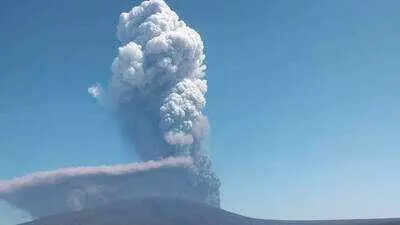Ethiopian Volcano Erupts: How Long Will India Be Affected & What’s the Next Destination?
Ash from Ethiopia’s massive volcanic eruption is expected to completely exit Indian airspace by 7:30 pm on Tuesday, the India Meteorological Department (IMD) confirmed. The plume, which passed over several northern and western states on Monday, briefly impacted flight operations and raised concerns amid continued poor air quality across Delhi.
Ash Drifting Out of India
IMD Director General Mrutyunjay Mohapatra said the ash plume is now “drifting towards China” and will move away entirely by Tuesday evening. The cloud first entered Gujarat, before spreading across Rajasthan, Maharashtra, Delhi-NCR, Haryana, and Punjab, carried by strong upper-level winds.
Cities such as Delhi and parts of Rajasthan experienced hazy skies late Monday night, although the impact is expected to ease steadily as the plume continues to move east.
How Did the Plume Reach India?
The ash was released from Hayli Gubbi, a shield volcano in Ethiopia’s Afar region, which erupted for the first time in nearly 10,000 years on Sunday. The eruption sent ash up to 14 km (45,000 ft) into the atmosphere.
The Toulouse Volcanic Ash Advisory Centre (VAAC) reported that the explosive activity began around 8:30 am GMT, after which the ash continued to travel despite the eruption slowing down.
The plume journeyed:
Satellite imaging, ash bulletins from VAACs, and atmospheric dispersion models helped forecasters track its movement, the IMD said.
Impact Across Indian States
Forecast models indicated noticeable ash presence over Delhi-NCR, Gujarat, Haryana, Punjab, Rajasthan, and Maharashtra, leading to reduced visibility in certain areas. Delhi’s air quality remained in the ‘very poor’ category, compounding ongoing pollution issues and raising further concern among residents.
Airlines were also asked to immediately report any incidents of suspected ash encounters, such as engine anomalies or in-cabin smoke or odour.
Several carriers, including IndiGo, Akasa Air, and KLM, were forced to revise schedules. Passengers experienced delays, longer flight paths, or rerouting as safety measures were implemented.
Authorities warned that some flights may continue facing increased travel time, holding patterns, or altered routes until the ash plume fully clears the region.
Situation Improving
With the ash cloud now shifting towards China, aviation and atmospheric conditions are expected to improve steadily through the evening. Continuous monitoring remains underway to ensure safe skies and minimal disruption for travellers in the coming hours.

Ash Drifting Out of India
IMD Director General Mrutyunjay Mohapatra said the ash plume is now “drifting towards China” and will move away entirely by Tuesday evening. The cloud first entered Gujarat, before spreading across Rajasthan, Maharashtra, Delhi-NCR, Haryana, and Punjab, carried by strong upper-level winds. Cities such as Delhi and parts of Rajasthan experienced hazy skies late Monday night, although the impact is expected to ease steadily as the plume continues to move east.
How Did the Plume Reach India?
The ash was released from Hayli Gubbi, a shield volcano in Ethiopia’s Afar region, which erupted for the first time in nearly 10,000 years on Sunday. The eruption sent ash up to 14 km (45,000 ft) into the atmosphere. The Toulouse Volcanic Ash Advisory Centre (VAAC) reported that the explosive activity began around 8:30 am GMT, after which the ash continued to travel despite the eruption slowing down.
The plume journeyed:
- From Ethiopia
- Across the Red Sea
- Into Yemen and Oman
- Over the Arabian Sea
- Before entering western and northern India
Satellite imaging, ash bulletins from VAACs, and atmospheric dispersion models helped forecasters track its movement, the IMD said.
Impact Across Indian States
Forecast models indicated noticeable ash presence over Delhi-NCR, Gujarat, Haryana, Punjab, Rajasthan, and Maharashtra, leading to reduced visibility in certain areas. Delhi’s air quality remained in the ‘very poor’ category, compounding ongoing pollution issues and raising further concern among residents. Advisories for Airlines
Aviation authorities responded quickly after the plume entered Indian skies. IMD’s Meteorological Watch Offices in Mumbai, Delhi, and Kolkata issued ICAO-standard SIGMET alerts, warning airlines to avoid affected altitudes and routes.The Directorate General of Civil Aviation (DGCA) also released a detailed advisory, urging airlines to monitor updates closely and adjust:
- Flight paths
- Fuel planning
- Routing decisions
Airlines were also asked to immediately report any incidents of suspected ash encounters, such as engine anomalies or in-cabin smoke or odour.
Flight Disruptions
Several carriers, including IndiGo, Akasa Air, and KLM, were forced to revise schedules. Passengers experienced delays, longer flight paths, or rerouting as safety measures were implemented. Authorities warned that some flights may continue facing increased travel time, holding patterns, or altered routes until the ash plume fully clears the region.
Situation Improving
With the ash cloud now shifting towards China, aviation and atmospheric conditions are expected to improve steadily through the evening. Continuous monitoring remains underway to ensure safe skies and minimal disruption for travellers in the coming hours. Next Story